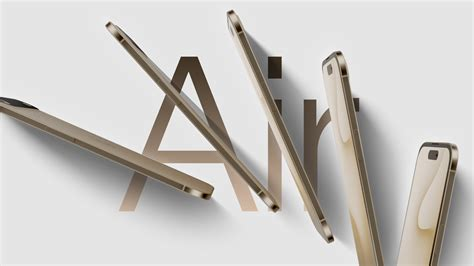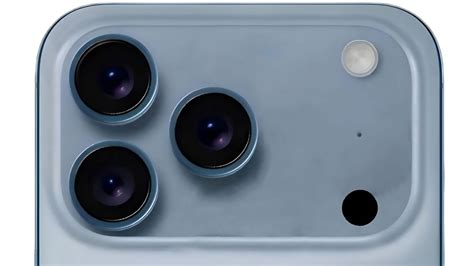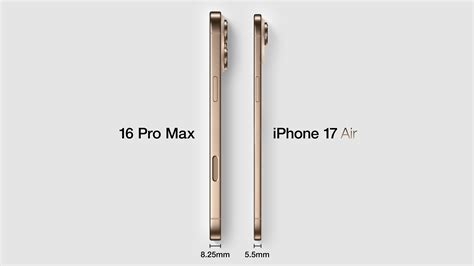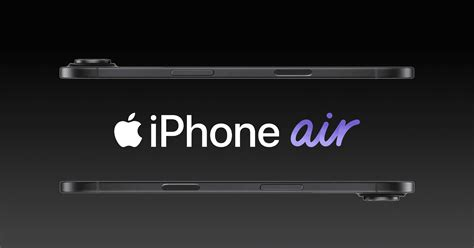iPhone Air Secrets
The iPhone Air has officially arrived at a staggeringly thin 5.6mm profile, replacing the Plus model in Apple's lineup. While the company proudly showcased this ultra-thin marvel during their biggest hardware refresh in years, we couldn't help but notice several key details that weren't highlighted during the presentation.
Despite its radical thinness, Apple claims the iPhone Air still delivers 27 hours of video playback—matching the old iPhone 16 Plus performance. At a starting price of $999, it sits somewhere between the iPhone 16 Pro and iPhone 15 Pro in terms of positioning. However, the contrast between the Air and the new iPhone 17 Pro models clearly demonstrates Apple's different design philosophies—one prioritizing sleekness, the other embracing performance. Additionally, the new device will feature a high-density battery alongside brand new processor technology.
In this article, we'll explore what Apple strategically omitted from their polished presentation. From design compromises to performance realities, we'll examine whether the iPhone Air truly represents innovation or merely a beautiful compromise.
The design gamble: thinness over features
At just 5.6 millimeters thin, the iPhone Air represents Apple's boldest design decision in years. This ultra-slim profile isn't just about esthetics—it's a calculated gamble that prioritizes form over certain features consumers have come to expect.
Why Apple replaced the iPhone Plus
The iPhone Air directly replaces the underperforming iPhone Plus model in Apple's 2025 lineup. Market data shows the Plus models only accounted for 5-7% of Apple's total iPhone shipments. Rather than continuing with a product line showing limited appeal, Apple chose to reinvent this mid-tier offering with a focus on thinness and lightness as the primary selling points.
What's missing in the ultra-thin form
To achieve this remarkable thinness, Apple made several significant compromises. Most notably, the device features just a single rear camera instead of the dual or triple camera systems found on other models. Furthermore, Apple eliminated the physical SIM card tray entirely, making the Air eSIM-only worldwide. This space-saving decision helps enable the impossibly thin form factor yet poses adoption challenges in markets like China where eSIM usage remains limited.
The slimmer profile also necessitated a smaller battery. Although Apple claims "all-day battery life", the company notably avoided specific capacity numbers during the presentation. Consequently, the Air only delivers an estimated 27 hours of video playback—significantly less than the iPhone 17 Pro Max's 39 hours.
MagSafe battery pack: a quiet admission?
Apple's simultaneous introduction of a new slim MagSafe battery pack exclusively for the iPhone Air appears to be a tacit acknowledgment of the battery limitations. For an additional $99, this accessory extends battery life to 40 hours, essentially turning the Air back into a regular-sized iPhone. Notably, this accessory works exclusively with the Air model, presumably because its shape isn't compatible with the camera bumps on other iPhone models.
Durability concerns with the new build
Given the iPhone 6 Plus "bendgate" controversy in 2014, concerns about the Air's structural integrity are inevitable. In anticipation of these worries, Apple emphasized that the titanium frame "exceeds Apple's stringent bend strength requirements". The company also introduced Ceramic Shield 2 for the front display, claiming 3x better scratch resistance, plus Ceramic Shield for the back with 4x better crack resistance than previous models.
Performance promises vs real-world use
Apple's latest event showcased impressive performance claims for the A19 Pro chip powering both the iPhone Air and iPhone 17 Pro models. Yet beneath the polished presentation lies a more nuanced reality worth examining.
A19 Pro chip: MacBook power or marketing spin?
During the keynote, Apple boldly proclaimed "MacBook Pro levels of compute in an iPhone", a claim that raises eyebrows. The A19 Pro features a 6-core CPU with 2 performance and 4 efficiency cores, supposedly delivering the fastest CPU in any smartphone. Moreover, the chip's Neural Accelerators offer 3x peak GPU compute over previous generations. Nevertheless, iPhone Air users get a slightly different experience with only a 5-core GPU compared to the Pro model's 6-core configuration.
Battery life claims vs actual capacity
Apple promises "all-day battery life" for the iPhone Air, specifically 27 hours of video playback and 22 hours of streaming video. In contrast, the iPhone 17 Pro delivers 33 hours of video playback, while the Pro Max reaches an impressive 39 hours. Given that regulatory filings reveal the Air's battery capacity at approximately 3,036-3,149 mAh — roughly 15% smaller than iPhone 16's 3,561 mAh battery — these claims appear optimistic. The introduction of a dedicated MagSafe Battery accessory further suggests Apple recognizes this limitation.
No vapor chamber: will it overheat?
Unlike the iPhone 17 Pro models that feature advanced vapor chamber cooling, the ultra-thin iPhone Air lacks this critical thermal management system. The Pro models utilize deionized water sealed inside a vapor chamber to draw heat away from the processor, enabling "virtually no throttling". Without this cooling system, the Air will likely face thermal constraints during intensive tasks, especially considering its impossibly thin profile.
iPhone 15 vs iPhone 16 vs iPhone 17 Air
Performance comparisons reveal the A19 Pro in iPhone Air offers 20% faster CPU and 50% faster GPU performance versus the iPhone 15 Pro. Compared to the iPhone 13's A15 Bionic, the improvement jumps to 50% faster CPU and 120% faster GPU performance. Yet the iPhone 17 Pro delivers slightly better results with up to 150% faster GPU performance over older models, primarily due to its extra GPU core and superior cooling.
AI and connectivity: the quiet compromises
Behind the sleek facade of the iPhone Air lies a series of noteworthy omissions in both AI capabilities and connectivity features. These compromises tell a revealing story about Apple's current technological priorities.
No AI Siri yet: what's the delay?
Since launching Apple Intelligence in late 2024, users have been particularly disappointed with improvements to Siri, which remains surprisingly basic despite years of promises. In fact, Apple's most ambitious AI features won't arrive until at least 2026. According to reports, the in-development version of the new Siri is simply too error-ridden to ship. This delayed timeline puts Apple far behind competitors like Google, who recently released their AI-powered Pixel 10.
C1X modem and lack of mmWave 5G
The iPhone Air introduces Apple's new C1X modem, which is:
- Up to 2x faster than the original C1 modem
- 30% more energy-efficient than the iPhone 16 Pro's modem
Yet clearly missing is mmWave 5G support, limiting the Air to sub-6GHz bands only. On the other hand, all other iPhone 17 models support both types of 5G. The Air does feature the new N1 wireless chip enabling WiFi 7, Bluetooth 6, and Thread networking.
Live translation in AirPods, not iPhone
Curiously, Apple's impressive new Live Translation feature debuted not on iPhone but through AirPods Pro 3. This hands-free capability works across English, French, German, Portuguese, and Spanish (with more languages coming). The feature requires an Apple Intelligence-enabled iPhone running iOS 26—yet the translation processing happens through AirPods rather than being an iPhone-native function.
Why Apple is leaning on third-party AI
Apple is reportedly partnering with Google to tap its search and AI expertise. Simultaneously, an AI-enhanced Siri might soon run on technology like Google Gemini. This approach could actually benefit consumers—allowing Apple to focus on hardware excellence while leveraging more advanced third-party AI technologies.
What Apple didn’t say about the future
Looking beyond the current release cycle reveals Apple's potential strategic moves with the iPhone Air. The radical design shift offers intriguing clues about Apple's future plans.
Is the iPhone Air a test for foldables?
The iPhone Air's ultra-thin design might be more significant than it appears. By pushing materials engineering to new limits, Apple gains valuable experience creating impossibly thin yet durable devices—precisely the expertise needed for foldable technology. Indeed, Apple has filed numerous patents for foldable display technology over the past three years. This test run with titanium and thin components could ultimately pave the way for Apple's first foldable iPhone.
How the Air fits into Apple's long-term lineup
The iPhone Air establishes a new premium mid-tier that sits between the standard iPhone 17 and the Pro models. This three-tiered approach—standard, thin premium, and professional—likely represents Apple's permanent strategy moving forward. Interestingly, this positions the Air as the spiritual successor to the Plus models but with an entirely different value proposition centered on design rather than screen size.
iPhone 12 Pro Max price vs today's mid-tier
When the iPhone 12 Pro Max launched in 2020, it retailed for $1,099. Today's iPhone Air starts at $999, essentially positioning yesterday's flagship price point at today's mid-tier level. This pricing strategy reflects both inflation and Apple's gradual feature segmentation between tiers.
What this means for iPhone 18 and beyond
The iPhone Air's reception will determine whether Apple continues this ultra-thin design philosophy. If successful, we'll likely see this approach extend throughout Apple's ecosystem. Possibly, the Air represents the beginning of a significant bifurcation in smartphone design—devices optimized either for thinness or for maximum performance and battery life.
Conclusion
The iPhone Air clearly represents Apple's boldest design gamble in years. At just 5.6mm thin, this device marks a significant shift in Apple's philosophy, prioritizing sleekness over the comprehensive feature set found in Pro models. Nevertheless, this ultra-thin marvel comes with notable compromises – a single rear camera, worldwide eSIM-only functionality, smaller battery capacity, and the absence of vapor chamber cooling technology.
Although Apple promises impressive performance from the A19 Pro chip, real-world usage might tell a different story. The thermal constraints of such a thin device will likely impact sustained performance during demanding tasks. Additionally, the company's decision to launch a dedicated MagSafe battery pack specifically for the Air seems to tacitly acknowledge its battery limitations.
The Air's positioning as a premium mid-tier option at $999 reflects Apple's strategic restructuring of its iPhone lineup. This three-tiered approach – standard, thin premium, and professional – likely represents the company's long-term strategy moving forward. Certainly, the consumer response to this ultra-thin design will determine whether Apple continues this design philosophy across future products.
Perhaps most interestingly, the iPhone Air might serve as a testing ground for Apple's future ambitions. The expertise gained from creating an impossibly thin yet durable device could ultimately pave the way for foldable technology. Therefore, while the Air might appear simply as an esthetic marvel, it potentially offers a glimpse into Apple's technological roadmap.
For prospective buyers, the decision comes down to priorities. Those valuing sleekness and portability above all else will find the Air compelling. Conversely, users demanding maximum performance, battery life, and camera capabilities would be better served by the Pro models. Undoubtedly, this distinct bifurcation in smartphone design philosophy – optimizing either for thinness or performance – might become increasingly common across the smartphone industry in coming years.
Key Takeaways
The iPhone Air represents Apple's boldest design gamble, prioritizing ultra-thin esthetics over comprehensive features, revealing strategic compromises that weren't highlighted at launch.
• Design over function: At 5.6mm thin, the iPhone Air sacrifices dual cameras, physical SIM slots, and battery capacity for unprecedented thinness, requiring a $99 MagSafe battery pack to match competitor performance.
• Performance limitations hidden: Despite A19 Pro chip promises, the Air lacks vapor chamber cooling found in Pro models, likely causing thermal throttling during intensive tasks.
• AI capabilities delayed: Apple's most ambitious Siri improvements won't arrive until 2026, forcing reliance on third-party AI partnerships while competitors advance ahead.
• Strategic testing ground: The Air may serve as Apple's experimental platform for foldable technology, with ultra-thin engineering expertise potentially paving the way for future innovations.
• Market repositioning: Priced at $999, the Air establishes a new premium mid-tier category, reflecting Apple's three-tiered strategy that positions yesterday's flagship prices at today's mid-range level.
The iPhone Air ultimately forces consumers to choose between sleek portability and maximum performance—a design philosophy that may define the future smartphone industry landscape.